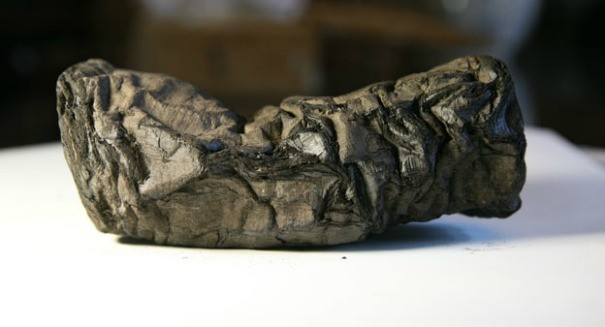
Researchers were able to decipher a few letters using X-rays, and hope to use the process to read the hundreds of other scrolls found during excavation of the site in the 18th century.
Scientists have found a way to use X-rays to read parts of an ancient scroll that was nearly completely burned up by the ancient eruption of Vesuvius nearly 2,000 years ago.
The scroll is one of many that have been retrieved from Herculaneum, which was buried along with Pompeii in the massive eruption in A.D. 79. Although some of the scrolls have been deciphered since their discovery in the 18th century, attempting to unroll the delicate papyrus has proved to be too damaging, and scientists stopped the practice.
However, a new X-ray technique shows that scientists may yet discover what is written within them, according to an Associated Press report.
Scientists have used X-rays before, but they were unable to provide any useful results as the ink was made using charcoal and gum, making it difficult to pick out from the burned papyrus.
Instead, Vito Mocello, who is a theoretical scientist at the Institute of Microelectronics and Microsystems (CNR) in Naples, Italy, used a method called X-ray phase contrast tomography. Instead of focusing on the chemical composition of the ink, it takes advantage of the way radiation passes through substances, and has been used in the past to examine fossils without damaging them.
The researchers used a lab at the European Synchotron Radiation Facility in France and were able to decipher a few letters, proving that the method could work.
The scientists further confirmed that the writing was from the poet and Epicurean philosopher Philodemus, who died about a hundred years before the eruption. They were able to determine it was his writing by comparing that to his other texts.
It is a painstaking process, however. The letters come in a jumbled mess due to how the papyrus is rolled and because it has been mangled and burned. Scientists will next try to automate the process of scanning the lumps of papyrus.
The scrolls come from the of Villa of the Papyri, a private house in the ancient Roman city of Herculaneum in southern Italy. The structure sits halfway up Mt. Vesuvius, and is believed to have been once owned by Julius Caesar’s father-in-law.
The eruption of Vesuvius blanketed the town with 30 meters of volcanic ash, and the area was not excavated until 1750. It is so named because researchers found 1,785 carbonized papyrus scrolls there.
The eruption of Vesuvius was one of the most catastrophic eruptions in European history. It was witnessed by Pliny the younger, a Roman poet, whose account has been used by historians to document the event. The volcano spewed ash and fumes 21 miles into the air, blasting molten rock at a rate of 1.5 million tons per second and producing energy a thousand times that of the bombing of Hiroshima. It obliterated the towns of Pompeii and Herculaneum. Archaeologists have found more than a thousand bodies, but the number who were killed could have been higher.

BX
I savor, cause I discovered just what I was looking for. You have ended
my four day long hunt! God Bless you man. Have a nice day.
Bye
Er blieb in Uppsala zur Training in
allgemeiner Chirurgie zwischen den Professoren
Gunnar Nyström unter anderem Olle Hultén; beide hatten
besonderes Stellenwert pro Rekonstruktive
Chirurgie. 1945 ging Skoog nach Finnland
um die Plastisch Chirurgische Erörterung
Kriegsverletzter zwischen solcher Ausbildung solcher
Professoren Richard Faltin im Übrigen Atso Soivio
zu
lesen. Im dann folgendem Jahr erhielt
er eine ‚British Council Scholarship‘ mit Sir
Harold Gillies nebst Sir Archibald McIndoe in
England. Nach dieser ‚Scholarship‘ kehrte er
zurück nach Schweden, wo er der/die/das ihm gehörende Thesis
anhand die Dupuytrensche Kontraktur Schreiben.
Wehrend des Korea-Krieges, erhielt er von
den ‚United Nations Forces‘ die Opportunität
zu einem Visite denn ‚Observer‘ eingeschlossen Entwerfen
eines Berichtes über Chip Heilverfahren vonseiten
Verletzten die dort Verbrennungen erlitten
hatten. Skoog wurde 1948 zum ‚appointed
director of plastic surgery of the University
Hospital of Uppsala‘ ernannt. Er erhielt
Einlagern in welcher Verband pro Hals-Nasen-Ohrenheilkunde,
entwickelte rasch seine eigene
Einheit für Schwerbrandverletzte neben wurde
zum ersten Professor bei Plastische Chirurgie
in Skandinavien ernannt. Er war ‚Honorary
Fellow of the American College of Surgeons‘
noch dazu wurde zum ‚Commodore, Oberste Dachkante Class of
the Finnish Order‘ vom Präsidenten ernannt.
That would make it easier for Fitbit to start making and selling
these merchandise.
whoah this blog is excellent i like reading your posts.
Keep up the good work! You realize, lots of persons are hunting around for this information, you can help them greatly.